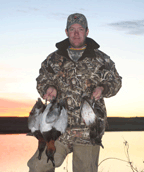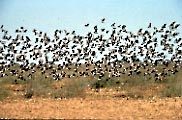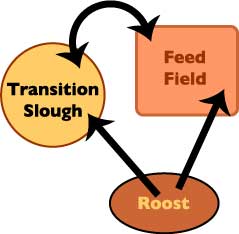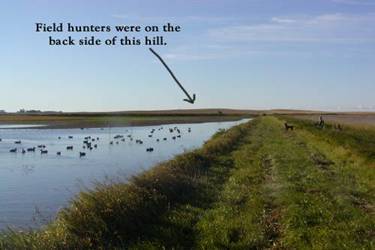Duck Hunting Tactics for North Dakota

There’s a lot of different ways to hunt ducks. You can field hunt, open water hunt, hunt shallow potholes, hunt flooded timber, pass shoot refuges, etc. etc. Every state has it’s own unique landscape, it’s own flyways, it’s own style of hunting. This philosophy definitely applies to duck hunting in North Dakota.
 What amazes me is the amount of duck boats that I see driving around the state in the month of October. This is the most common practice in most areas of the Central and Mississippi flyways. But North Dakota is a little different, and I suggest to hunters to try coming with a different arsenal this year. In a lot of cases, especially late in the year, boats can be ideal for getting into the back areas where the ducks are holding. But most of the time I would say they’re not needed at all.
What amazes me is the amount of duck boats that I see driving around the state in the month of October. This is the most common practice in most areas of the Central and Mississippi flyways. But North Dakota is a little different, and I suggest to hunters to try coming with a different arsenal this year. In a lot of cases, especially late in the year, boats can be ideal for getting into the back areas where the ducks are holding. But most of the time I would say they’re not needed at all.
When the pressure gets high in the state, the ducks will move to open water. With the large amount of jump shooting, they will target the areas where they will feel safe. These will usually be in the middle of those hard to reach areas. But these are the roost areas, and to keep quality hunting for everyone, these areas need some rest. There’s only so much pressure they can receive before they will make their temporary home down south, never to return again that fall. So in studying the patterns of ducks in North Dakota, you have to understand all of the possibilities that are available to you. The easiest hunting situations lie miles away from the roosts.

On the prairie, ducks are pretty predictable. They will leave the roost in the morning, and head for the direction of their feeding fields. About half the time they will head straight for the field to feed, and the other half they’ll temporarily stop over in an adjoining pothole to group up. In my opinion, these are the areas hunters should be targeting. You can target the birds in the field, or in the adjoining pothole. With a pair of waders, and a few dozen decoys, you can be sure to have birds in your face. Or with a duck field spread, and/or goose decoys, you can have quality wing shooting in the field. With this style of hunting, we’ve always been able to have good shooting and at the same time, not burn out the roost. The result is consistency, as you’ll always be ensured large amounts of birds in the area to hunt. Roost hunting will bring short term results, with dramatic effects in the long term in bird numbers.
I’ll explain a situation that we used on the opening weekend of duck hunting 2002 and still applies today. While scouting at night, we found a roost full of puddler ducks. Towards the later evening, the birds started flying off in waves to a feed field a mile or two away. At the same time, the birds were short stopping the field by about a mile, in a flooded field off a prairie road. At first glance, my buddy was eyeing the field while I was eyeing the flooded field. So we decided to split up and give them both a chance.
My buddies set up off a fence line, and put the decoys about 45 yards upwind of the fence. They put up dozens of goose and duck decoys, and a couple of spinners. The wind that morning was pretty brisk, so it forced the ducks over the hunters in route to the decoys. We weren’t too far away in the flooded field, and could hear their success. They filled that morning with a bag of mallards, pintails and wood ducks. At the same time…
We set up in the flooded field off of the prairie road. We used the natural cover to hide, and started filling the water with decoys the same way they had the night before. We set out two large groups, with a landing zone in between. We also put the spinners towards the middle to bring the birds into the middle of the shooters. As you can see by our picture, we were set up about a mile from the field spread.

We ended up with a full bag of mallards, with a few pintails mixed in. The flooded field we hunted is in the background of the grindage photo.
Later that morning, we watched as thousands of birds poured back into the roost. And that evening, there was an explosion of ducks into the fields and potholes a couple miles away, giving another group of hunters a great opportunity. If we would’ve hunted the roost that morning, I’d assume the birds would be at least a couple townships away and out of the area.
So if you’re coming out to North Dakota for ducks, I recommend bringing your waders, floaters, and a field spread. You’ll be equipped to hunt ducks in almost every situation, and you’ll keep plenty of birds in the area for your group and all others in the area. Give it a try the next time you’re out in the prairie. This is the style of North Dakota waterfowling in the prairie pothole region. Best of luck this year!
Chris Hustad is owner of nodakoutdoors.com, a hunting and fishing portal that encompasses North Dakota’s hunting heritage. This article originally appeared on www.nodakoutdoors.com.
{loadposition signup}

Irwin Greenstein is Publisher of Shotgun Life. Please send your comments to letters@shotgunlife.com.


Comments